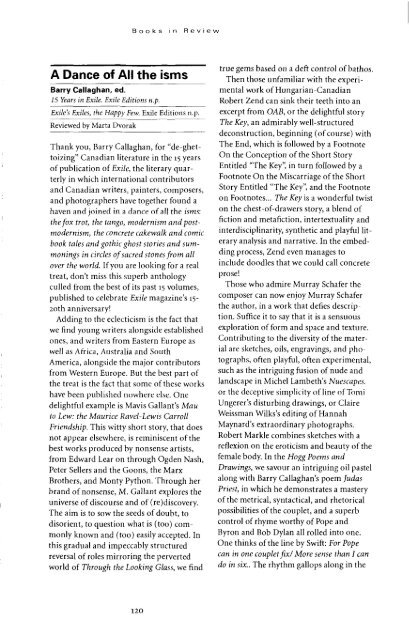The Carpathians - University of British Columbia
The Carpathians - University of British Columbia
The Carpathians - University of British Columbia
Create successful ePaper yourself
Turn your PDF publications into a flip-book with our unique Google optimized e-Paper software.
A Dance <strong>of</strong> All the isms<br />
Barry Callaghan, ed.<br />
15 Years in Exile. Exile Editions n.p.<br />
Exile's Exiles, the Happy Few. Exile Editions n.p.<br />
Reviewed by Marta Dvorak<br />
Thank you, Barry Callaghan, for "de-ghettoizing"<br />
Canadian literature in the 15 years<br />
<strong>of</strong> publication <strong>of</strong> Exile, the literary quarterly<br />
in which international contributors<br />
and Canadian writers, painters, composers,<br />
and photographers have together found a<br />
haven and joined in a dance <strong>of</strong> all the isms:<br />
the fox trot, the tango, modernism and postmodernism,<br />
the concrete Cakewalk and comic<br />
book tales and gothic ghost stories and summonings<br />
in circles <strong>of</strong> sacred stones from all<br />
over the world. If you are looking for a real<br />
treat, don't miss this superb anthology<br />
culled from the best <strong>of</strong> its past 15 volumes,<br />
published to celebrate Exile magazine's 15-<br />
20th anniversary!<br />
Adding to the eclecticism is the fact that<br />
we find young writers alongside established<br />
ones, and writers from Eastern Europe as<br />
well as Africa, Australia and South<br />
America, alongside the major contributors<br />
from Western Europe. But the best part <strong>of</strong><br />
the treat is the fact that some <strong>of</strong> these works<br />
have been published nowhere else. One<br />
delightful example is Mavis Gallant's Mau<br />
to Lew: the Maurice Ravel-Lewis Carroll<br />
Friendship. This witty short story, that does<br />
not appear elsewhere, is reminiscent <strong>of</strong> the<br />
best works produced by nonsense artists,<br />
from Edward Lear on through Ogden Nash,<br />
Peter Sellers and the Goons, the Marx<br />
Brothers, and Monty Python. Through her<br />
brand <strong>of</strong> nonsense, M. Gallant explores the<br />
universe <strong>of</strong> discourse and <strong>of</strong> (re)discovery.<br />
<strong>The</strong> aim is to sow the seeds <strong>of</strong> doubt, to<br />
disorient, to question what is (too) commonly<br />
known and (too) easily accepted. In<br />
this gradual and impeccably structured<br />
reversal <strong>of</strong> roles mirroring the perverted<br />
world <strong>of</strong> Through the Looking Glass, we find<br />
true gems based on a deft control <strong>of</strong> bathos.<br />
<strong>The</strong>n those unfamiliar with the experimental<br />
work <strong>of</strong> Hungarian-Canadian<br />
Robert Zend can sink their teeth into an<br />
excerpt from OAB, or the delightful story<br />
<strong>The</strong> Key, an admirably well-structured<br />
deconstruction, beginning (<strong>of</strong> course) with<br />
<strong>The</strong> End, which is followed by a Footnote<br />
On the Conception <strong>of</strong> the Short Story<br />
Entitled "<strong>The</strong> Key", in turn followed by a<br />
Footnote On the Miscarriage <strong>of</strong> the Short<br />
Story Entitled "<strong>The</strong> Key", and the Footnote<br />
on Footnotes... <strong>The</strong> Key is a wonderful twist<br />
on the chest-<strong>of</strong>-drawers story, a blend <strong>of</strong><br />
fiction and metafiction, intertextuality and<br />
interdisciplinarity, synthetic and playful literary<br />
analysis and narrative. In the embedding<br />
process, Zend even manages to<br />
include doodles that we could call concrete<br />
prose!<br />
Those who admire Murray Schafer the<br />
composer can now enjoy Murray Schafer<br />
the author, in a work that defies description.<br />
Suffice it to say that it is a sensuous<br />
exploration <strong>of</strong> form and space and texture.<br />
Contributing to the diversity <strong>of</strong> the material<br />
are sketches, oils, engravings, and photographs,<br />
<strong>of</strong>ten playful, <strong>of</strong>ten experimental,<br />
such as the intriguing fusion <strong>of</strong> nude and<br />
landscape in Michel Lambeth's Nuescapes.<br />
or the deceptive simplicity <strong>of</strong> line <strong>of</strong> Tomi<br />
Ungerer's disturbing drawings, or Claire<br />
Weissman Wilks's editing <strong>of</strong> Hannah<br />
Maynard's extraordinary photographs.<br />
Robert Markle combines sketches with a<br />
reflexion on the eroticism and beauty <strong>of</strong> the<br />
female body. In the Hogg Poems and<br />
Drawings, we savour an intriguing oil pastel<br />
along with Barry Callaghan's poem Judas<br />
Priest, in which he demonstrates a mastery<br />
<strong>of</strong> the metrical, syntactical, and rhetorical<br />
possibilities <strong>of</strong> the couplet, and a superb<br />
control <strong>of</strong> rhyme worthy <strong>of</strong> Pope and<br />
Byron and Bob Dylan all rolled into one.<br />
One thinks <strong>of</strong> the line by Swift: For Pope<br />
can in one couplet fix/ More sense than I can<br />
do in six.. <strong>The</strong> rhythm gallops along in the

















